climate change
Design out CO2
30% reduction in CO2 per tonne of product compared to 1990.
“Securing this innovation funding is an extremely positive step for our industry as we support the UK’s ambition of achieving net-zero carbon emissions by 2050. Collaborative working and embracing innovative technologies are key to delivering strategic plans for decarbonisation.”
Mike Eberlin, managing director, Cement and Lime
Addressing climate change is a cornerstone of our approach to sustainability.
highlights
24%
41%
Replacement of fossil fuels in cement
£6 million
For a long time now, Tarmac has been fully committed to supporting the UK's ambition of net zero carbon emissions and collaborating with our supply chain and customers to do the same. Across our value chains there are many technologies that can support significant advances to reduce these emissions. Most of these are well known today and simply require scaling-up and the right policy environment. Others require further research and development.
We have continued to apply a whole life approach and have taken steps to tackle CO2 emissions right across our business. We are engaging with our supply chain to reduce CO2 from the goods and services we buy. We review our manufacturing operations and transport to understand where emissions arise, the reduction technologies available and take action to implement them. We also use whole life cycle thinking to innovate lower carbon solutions that can support our customers to reduce CO2 during the construction process, or during the use of their building or infrastructure asset.
At the end of 2020 we had achieved a 24 percent reduction in CO2 per tonne of product compared to 1990. We are pleased with our progress, but it was short of the ambitious milestone target of 30 percent reduction. This was in part due to changes in Government incentives for renewable electricity which reduced the availability of waste biomass in the cement sector and because of unexpected impacts such as COVID-19. We understand the scale of the net zero challenge ahead and will continue to set and drive towards ambitious carbon reduction targets in our new sustainability strategy.
Investment in plant and equipment
In 2020, Tarmac continued to invest in modern efficient plant and equipment. We have created a new rail connected construction materials hub to serve the Birmingham region at Washwood Heath. Rail connectivity reduces transport emissions and local transport impacts. The new hub operates using on-site generated renewable electricity and the manufacturing plants are designed to produce lower carbon concretes and asphalts, such as ULTILOW, (which is produced at lower temperatures), and to use up to 40 percent of recycled old road surfaces in new asphalt products.
We have also announced plans to invest in a new cement kiln chlorine bypass at our Tunstead cement operation in Derbyshire. This new technology will enable the plant to significantly increase its use of waste-derived fuels in place of fossil fuels.
At four of our Alun Griffiths sites we have trialled solar panel generators in place of diesel powered generators, to establish a more sustainable solution to off-grid power for sites that cannot be connected to mains electricity. The solar panel generators provided a carbon saving of 45.5 tCO2e.
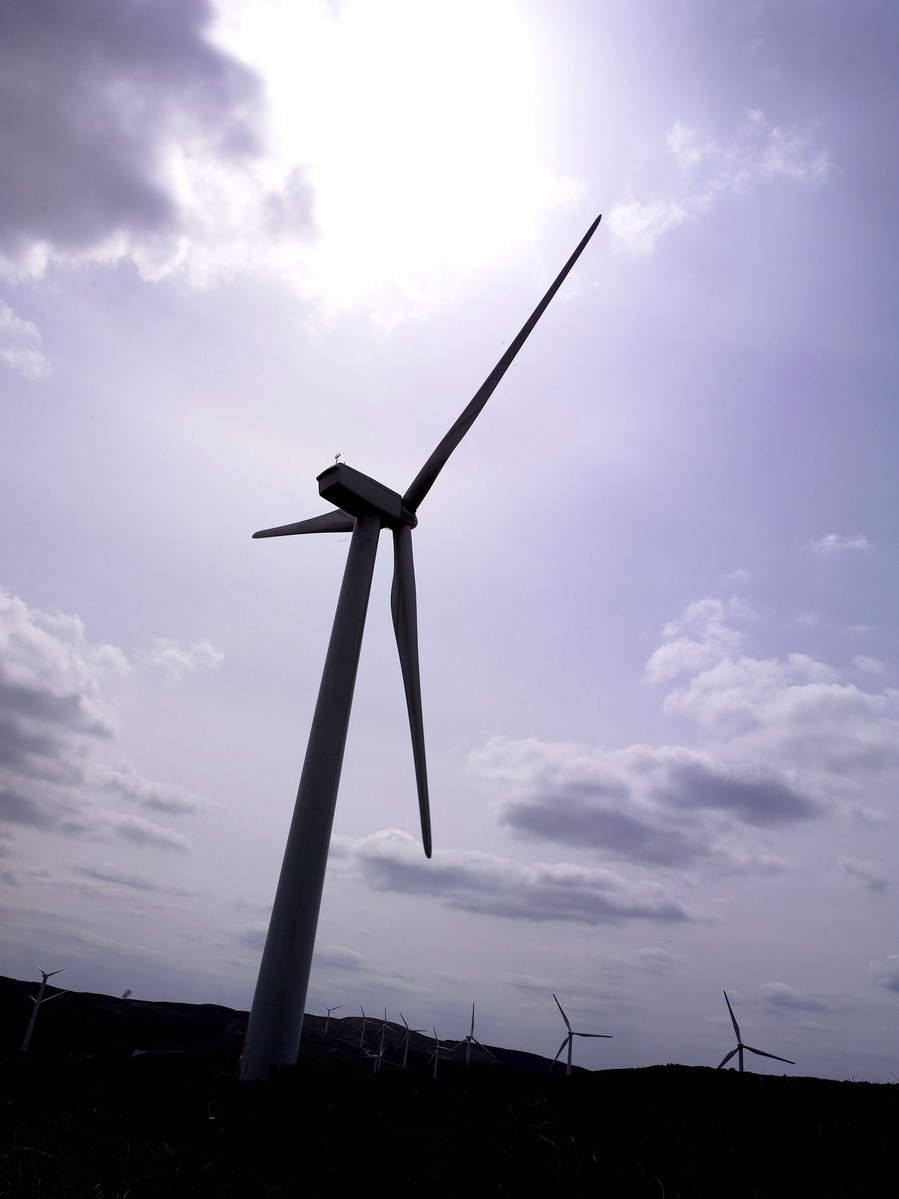
Energy efficiency
We believe that improving energy efficiency and optimising plant performance is good practice in reducing CO2. We use our certified ISO 50001 Energy Management System to drive continuous improvement in energy, set specific energy consumption (SEC) and CO2 targets and to monitor performance at every one of our manufacturing sites. These targets are tightened each year to drive continuous improvement and investment in lower CO2 plant and operations. Our ISO 50001 system is independently assessed each year to helps us ensure that all our operations are compliant with regulatory requirements, such as the UK Government’s Energy Savings Opportunity Scheme (ESOS).
Using lower CO2 energy
We are committed to using lower CO2 fuels wherever this is technically and economically feasible. We have switched from traditional fossils fuels to lower carbon alternatives, for example moving from gas oil to natural gas or LPG, and over the years our cement business has continued to replace the fossil fuels with waste-derived fuels, including waste-derived fuels that have a significant biomass content.
In 2020, over 41 percent of the heat input needed in our cement kilns came from waste-derived fuels, this included 13.6 percent from biomass. The types of fuels used across our cement operations now include waste tyres (whole or chipped), solid recovered fuel (SRF) from non-hazardous materials including paper, cardboard, plastics, textiles and waste wood chips, recycled liquid fuel, processed sewage pellets (PSP) and polymer chip. Fuels such as PSP are 100% biomass while tyres, SRF and polymer chip contain a proportion of biomass. The use of waste-derived fuels containing biomass makes a significant contribution to reducing CO2 emissions as waste biomass is considered carbon neutral.
During the year our business also stepped forward to take part in a ground-breaking project to explore the potential of plasma energy and hydrogen technology in the production of cement and lime. The research is being funded by the Department for Business, Energy and Industrial Strategy (BEIS) which has awarded £6.02 million to the Mineral Products Association (MPA) for fuel switching trials. Tarmac’s Tunstead cement plant in Derbyshire will be host to some of the cement trials and will also be used to explore the viability of hydrogen as an alternative to natural gas for high calcium lime manufacturing.
Our long-term power purchase agreement (PPA) with our electricity supplier ensures that 100 percent of the electricity we purchase across the whole of our business comes from a renewable energy source (a mix of wind and solar energy). This is backed up by Renewable Energy Guarantees of Origin (REGOs) to prove the electricity was produced only from renewable sources.
As with many businesses, Tarmac experienced a pronounced reduction in business travel and its associated CO2 emissions during the COVID-19 pandemic. As we return to a new normal, we would expect business travel to increase from 2020 levels, but we intend to take advantage of the lessons learnt, for example, by encouraging employees to travel only where necessary, to use greener transport options, to continue to use video conferencing and by increasing flexible working arrangements.
We are taking other actions on emissions from business travel and are the first in our sector to sign up to EV100, a commitment to upgrade our entire 2,000-strong fleet of corporate cars and vans to electric vehicles (EV), as well as installing EV charging points and infrastructure in key business locations across the country. The EV100 is a global initiative bringing together businesses committed to accelerating the transition to electric vehicles.
We continue to support our customers to deliver the transition to a low carbon built environment by redesigning and rethinking the way we make our products, the constituent materials used, considering capital carbon and assessing the whole-life performance benefits our products can bring. We provide a wide range of products that help our customers save carbon now and during the life time of their project.
Our innovative solutions include:
- Improving the durability of our products, meaning that products need to be replaced or maintained less frequently.
- Use of recycled or secondary materials in products, such as ground granulated blast furnace slag and fly ash instead of clinker to reduce the CO2 in cement and concrete or use old road surfacing (Recycled Asphalt Planings) to replace primary materials in new asphalt.
- Creating new products that have a lower carbon footprint.
- Providing product carbon footprint information enabling better choices about design and material selection.
- Raising awareness through collaboration, early engagement and providing guidance like our Solutions Guides that demonstrate how our products and solutions can be used to reduce operational CO2 emissions from buildings and infrastructure.
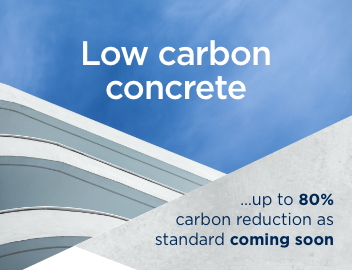
The transition to a net zero society requires collaboration across governments, industries and society to develop the solutions needed for a more climate-resilient world. Tarmac collaborates with a wide range of organisations to support a just transition to a net zero society in the most cost-efficient manner, avoiding the offshoring of UK manufacturing, investment, jobs and economic value. Our collaborations include a wide range of industry trade bodies at global, European and UK level, For the construction industry to align with UK’s net zero commitments and deliver CO2 emissions reductions, it will require support and funding from governments across a range of policy measures. A selection of our wide ranging collaborations is provided below:
Tarmac has been actively involved in the development of and are proud to support, the UK Concrete and Cement industry ‘Beyond Net Zero’ roadmap. The roadmap sets out how by 2050 the UK concrete and cement industry will not only achieve net zero carbon but go beyond net zero, to remove more carbon dioxide from the atmosphere than it emits each year. The key levers for decarbonisation include transitioning to renewable electricity, switching to lower CO2 waste-derived fuels, developing low carbon cement formulations and implementation of carbon capture use or storage (CCUS). Beyond net zero is achieved without the need for offsets. The additional benefits of concrete in reducing CO2 emissions from the built environment during its use help concrete to be net negative. These include using concrete’s inherent thermal mass properties, that can significantly reduce energy required to heat or cool buildings, and its ability to ‘recarbonate’, a natural process whereby it reabsorbs and permanently locks up a significant proportion of CO2 over its life.
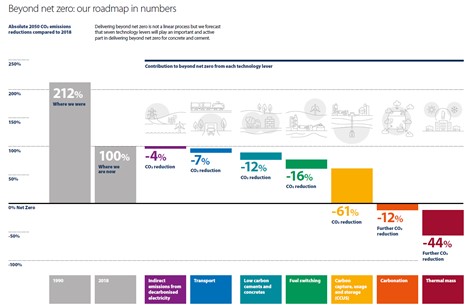
The roadmap highlights the steps industry will need to take and the policy and economic support measures needed from Government, including investment in enabling infrastructure like electricity grid capacity, hydrogen networks and CO2 transport and storage.
UK Cement and Concrete sector has already reduced CO2 emissions by 53% since 1990
CO2 in cement and concrete is commonly reduced by substituting it with a proportion of a secondary component, such as fly ash or blast furnace slag. Tarmac already provide a wide range of these low carbon concretes. These are currently limited by UK concrete product standards to just one type of addition for each type of cement. With funding from the Government’s Industrial Energy Efficiency Accelerator (IEEA), Tarmac is working with MPA Cement, the Building Research Establishment and other cement producers to develop new lower carbon multi-component cements and demonstrate they are fit for purpose in a wide range of UK concrete applications. This will open the way for these lower carbon options to be used confidently by architects, specifiers and designers.
South Wales Industrial Cluster (SWIC)
The South Wales Industrial Cluster is a group of major industrial companies, academics and other experts in the region stretching from the Pembrokeshire Coast to the Severn Bridge along the M4 corridor. This group is working collaboratively to identify ways to tackle common and unique challenges of decarbonisation and clean growth. Tarmac is directly involved in projects on defining a net zero roadmap for South Wales, deployment of CO2 reducing technologies and circular economy.
Scottish Industrial Cluster (NECCUS)
Tarmac is a member of NECCUS (pronounced nexus), an alliance of industry, government and experts, united to drive the changes and support the programmes needed to reduce CO2 emissions from industrial sources in Scotland and beyond. At its heart is a project known as Acorn which is set to deliver a carbon capture and storage programme for Scotland by 2024 and which can be scaled-up to support other projects across the UK, as well as enabling hydrogen to be used more widely as a source of clean energy. Tarmac participates in the work to define a Scotland Net Zero Roadmap.
Peak Cluster
Tarmac is collaborating with other companies in and around the Peak District to collectively find solutions to decarbonise the region. The Peak Cluster links into the Net Zero North West initiative and Hynet project.
For the construction industry to align with the UK’s net zero commitments and deliver CO2 emissions reductions, it will require support and funding from central and devolved governments across a range of policy measures. The Governments own Industrial Decarbonisation Strategy recognises that industry should not wrongly lose their competitiveness because of their exposure to more stringent emissions targets than their global competitors. It is vital that decarbonisation is achieved through a just transition and without displacing domestic manufacturing and jobs overseas. Responsible corporate lobbying is a key principle underpinning our interactions with policy makers directly, and indirectly through industry associations, in relation to all aspects of the Tarmac business, including climate change.
Construction Leadership Council - Green Construction Board – Low Carbon Concrete
We are a key signatory of the UK Government’s Infrastructure Carbon Review (ICR) which aims to cut 24 million tonnes CO2 from UK infrastructure projects by 2050. In support of the ICR Tarmac played an active role in the development of PAS 2080, the world’s first specification for Carbon Management in Infrastructure. During 2020, we have worked with the Green Construction Board’s Low Carbon Concrete Group (LCCG). The LCCG consists of over 18 organisations from the construction sector working together to develop a route map for adoption by the industry to assist designers, engineers, clients and the wider construction sector to reduce the carbon impact of construction activities. The low carbon concrete route map will be launched in Autumn 2021 and will help construction professionals to understand and select the lowest carbon concrete design options for their projects.
At the end of 2020, we had achieved a 24 percent reduction in CO2 per tonne of product compared to 1990. We categorise our greenhouse gas emissions into direct and indirect sources in line with the Greenhouse Gas Protocol.
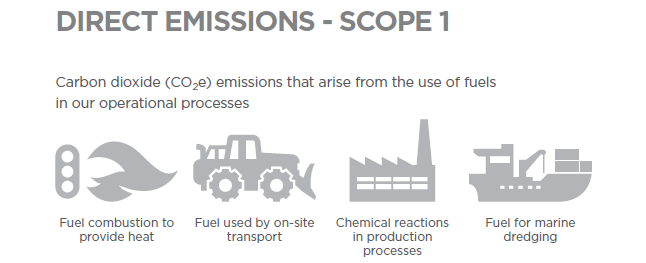
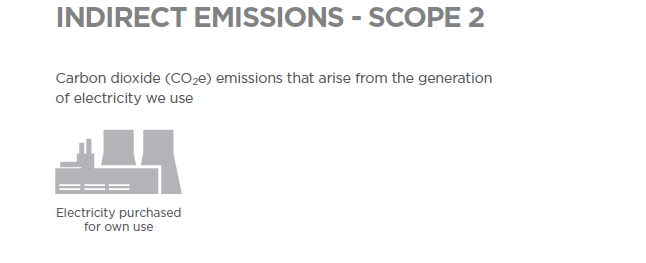
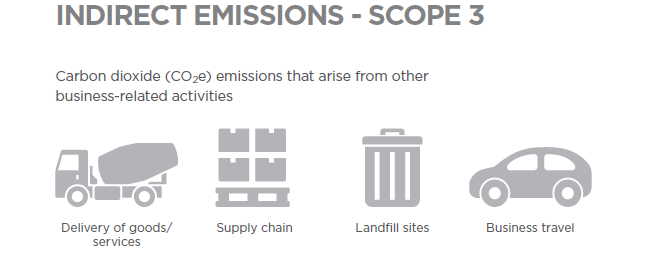
Carbon dioxide is one of six greenhouse gases that are emitted when humans undertake certain activities. Other greenhouse gases include methane, nitrous oxide and ozone – all of which occur naturally in our atmosphere. To take into account the emission of other greenhouse gases when calculating the level of greenhouse gas emissions, scientists have devised an equivalent measure – CO2e (which literally means carbon dioxide equivalent). CO2e allows other greenhouse gas emissions to be expressed in terms of CO2 based on their relative global warming potential (GWP).
So when you see a carbon footprint expressed in terms of CO2e, you can know for sure that all greenhouse gases have been included for each activity under scope, and therefore a fuller picture of an organisation's impact has been captured.
| 1000’s tCO2e | % | |
|---|---|---|
| Scope 1 | 2,043 | 77.14% |
| Scope 2 | 109 | 4.12% |
| Scope 3 | 497 | 18.75% |
| 2,649 | 100% |
Note: Scope 3 emissions have increased this year due to the inclusion of estimated supply chain emissions from external constituent materials used in our products.
| tCO2e | % | |
|---|---|---|
| Process emissions | 1,218,867 | 56.65% |
| Coal | 281,098 | 13.07% |
| Electricity | 108,547 | 5.05% |
| Waste derived fuel (WDF) | 135,005 | 6.28% |
| Natural gas | 182,841 | 8.50% |
| Gas oil | 111,618 | 5.19% |
| Petcoke | 30,126 | 1.40% |
| Processed fuel oil (PFO) | 18,598 | 0.86% |
| Kerosene | 7,350 | 0.34% |
| Marine Diesel | 20,168 | 0.94% |
| Liquid Petroleum Gas (LPG) | 37,228 | 1.73% |
| Energy use by source (GJ) | % | |
|---|---|---|
| Coal | 3,021,775 | 23.52% |
| Electricity | 1,676,112 | 13.05% |
| Waste derived fuel (WDF) | 1,598,683 | 12.44% |
| Natural gas | 3,392,534 | 26.41% |
| Gas oil | 1,561,779 | 12.16% |
| Petcoke | 332,127 | 2.59% |
| Processed fuel oil (PFO) | 250,057 | 1.95% |
| Kerosene | 107,277 | 0.84% |
| Marine Diesel | 281,020 | 2.19% |
| Liquid Petroleum Gas (LPG) | 624,836 | 4.86% |
| Total | 12,846,201 | 100.00% |
This includes non biomass waste derived fuels only, we also used 41,152 tonnes of biomass waste derived fuels.
Having reached the end of 2020, we are about to launch the next phase of our sustainability strategy. Our goal is to play a full part in taking climate action as we help to deliver a transition to a net zero society. The built environment accounts for about 42 percent of the UK’s greenhouse gas emissions and so the construction sector will have a pivotal role to play. Tarmac will continue to take action to switch to lower carbon fuels, develop lower carbon cement and concrete formulations. We are working hard to reduce direct emissions from our activities and processes, and we recognise the contribution we can make to society as we strive for carbon neutrality along the cement and concrete value chain.
Our 2030 carbon target, when combined with the development of our net zero roadmaps and other strategic climate-related actions, supports our overarching commitment for the business to be net zero before 2050.